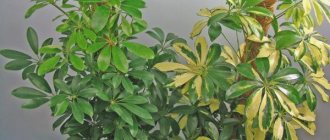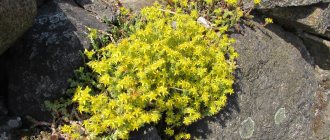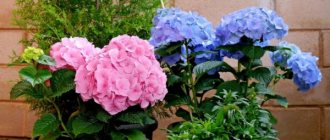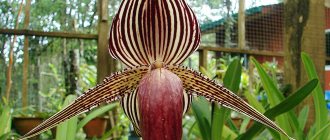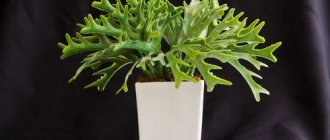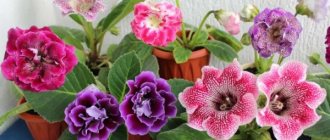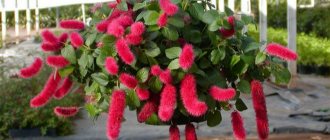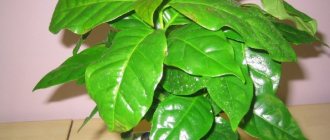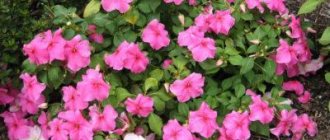Many gardeners grow netcreasia (also called tradescantia) as an hanging plant, periodically pruning the rapidly growing stems. You can use overgrown flowerpots in the form of living partitions or curtains, covering a door or window opening with them. The shoots are partially directed upward, and the remaining ones hang down. You can also grow the plant in a flowerbed - netcreasia fits well into landscape design. In the fall it needs to be dug up and moved into the house.
Description
The plant is native to the eastern part of Mexico (Gulf Coast).
It grows in the highlands of Mexico along with cacti and agaves. The stems and leaf blades are purple-lilac-greenish in color, the leaves are sparsely pubescent, oblong-lanceolate in shape, their length is about 10 cm, width - up to 3 cm, the apex is slightly pointed. The flowers are pink in color, up to 2 cm in diameter, the flowering phase lasts from May to August.
Setcreasia needs frequent watering, but care must be taken to ensure that moisture does not stagnate. The flowerpot should be placed in a well-lit place so that the plant has a rich purple color (the indoor plant should be in direct light for 2-3 hours a day, preferably in the morning).
There is a sign that if a single woman brings netcreasia into her house, she will soon meet her betrothed.
If the plant grows in the apartment of a married woman, it will protect against adultery and save the marriage. Setcreasia will relieve the owner of the love spell, reduce negativity and stress.
Varieties of netcreasia
Let's look at some types and varieties of netcreasia.
Setcreasia green
This is a perennial plant with leaves of a light green hue. During the flowering period, milky white flowers appear. Each bud is located at the very top of the shoot.
Setcreasia purpurea
This herb is characterized by leaves with fluff. On one side, the leaf plates are painted crimson-red. The other side is purple. During the flowering period, flowers of lilac, violet or pink shades grow. Each one always has three petals.
Setcreasia striata
This flower also has creeping shoots. It has long, small leaves that have a very velvet-like surface to the touch. The colors of the sheet plates are always different and always unusual. Rarely are they monochromatic. One side is most often a bright emerald shade. It contains stripes of different sizes. The reverse side is lilac or purple in color. Since the buds are quite small, the flowering period is practically no different from all other periods. After all, flowers, if you don’t look closely, you might not notice
They are usually lilac or purple-pink in color. You must monitor the plant very carefully and treat it with the utmost caution.
After all, the older he gets, the more fragile he becomes. One extra movement can cause all the shoots to collapse. Just because you don't touch the netcreasia doesn't mean it won't break. Quite often the plant falls apart due to its own weight.
Kinds
Setcreasea purpurea
Setcreasea purpurea
The stems and leaf blades are slightly pubescent, purple-green above, purple below. In summer, small pink flowers bloom in the axils of the leaves. Used as an ampel crop.
Setcreasea pallida
Setcreasea pallida
This is another name for Setcreasia purpurea. The length of the stems is, as a rule, about 100 cm, the leaves are elongated-lanceolate, their length is up to 17 cm, width is about 3.5 cm. The apex of the leaf blade is slightly pointed, the leaves are purple-lilac in color.
Setcreasea viridis
Setcreasea viridis
The shape of the leaf blades is elongated, the apex is pointed, the shade is green-pistachio. The leaves are slightly pubescent, the flowers are collected in bunches.
Setcreasea striata
Setcreasea striata
The leaf blades are small, velvety, rounded at the base, the apex is slightly pointed. On the upper side, the shade of the leaf is bronze-green with longitudinal stripes of a whitish shade; on the bottom, the color of the leaf blade is pink-lilac. Flowers of a lilac hue.
Types and varieties of indoor Tradescantia
Caring for indoor pomegranate at home, how to grow a plant from a seed in a pot, planting and pruning
Many types of Tradescantia are grown as house, container or garden plants. Despite the external diversity, the generic affiliation is clearly visible.
What differs most from others is:
- succulent species of Tradescantia with short internodes and small thick leaves folded in a boat;
- reo with long sword-shaped plates and an erect stem;
- callisias, which can be classified as an independent genus;
- zebrins are typical Tradescantia, which were previously considered separately for unknown reasons;
- Setcreasia is a group of several Tradescantia species with lanceolate, inky leaves.
| Russian and Latin name | Description | Varieties |
| White-flowered, Tradescantia albiflora | Herbaceous perennial with creeping geniculate stems. The leaves are ovate, length and width are up to 6 and 2 cm, respectively. The plates of the plant are monochromatic green, varieties have white, silver, golden or inky stripes. The flowers are white. | Tricolor, Aurea, Albovitata, Aureovitata |
| Blossfeldiana, Tradescantia blossfeldiana | Tradescantia is distinguished by purple creeping shoots and a fleecy underside of the leaves. The plates are oval to lanceolate, with a sharp elongated tip and a base covering the stem, up to 8 cm long and no more than 3 cm wide. The front side of the leaves is dark green with a purple tint. The flowers are lilac. | Variegata |
| Virginian, Tradescantia virginiana | It grows up to 60 cm, the stems are even, branched, the leaves are erect, xiphoid, about 20 cm long with a maximum width of 4 cm. Tradescantia flowers are pink-violet, large, up to 4 cm in diameter, in varieties they can be red or blue. They open in July-August. | Rubra, Rosea, Coerulea, Atrorubra |
| Hairy, Tradescantia pilosa | The aerial part of this Tradescantia is covered with thick whitish hairs, which is why the plant appears silvery. The stems are erect, the leaves are elongated-ovate, the flowers are bright pink. | |
| Zebrina, Striped, Zebra-tailed, Tradescantia zebrina | Perennial ampelous Tradescantia with flexible shoots. The leaves are pointed, elongated-ovate, sessile, up to 11 cm long and 6 cm wide (usually less). The color of the plates is green on top with two silvery longitudinal stripes, and ink on the bottom. Small purple flowers bloom in spring and autumn. | Quadicolor, Red Hill, Purpuzi |
| Scaphoid, Callisia Navicularis, Tradescantia navicularis | Succulent with creeping stems. The leaves of the plant are thick, 1-2 (maximum - 4) cm, green, in good light - with an inky underside. The shape of the plate is keeled at the base, with a sharp tip. This Tradescantia leaf seems to be folded along the central axis, with cilia along the edge. Purple or pink flowers bloom alternately from spring to early autumn. | There are red and purple varieties |
| Small-leaved, creeping callisia, Tradescantia microphylla | Ground cover or ampelous Tradescantia, the most delicate of the species. Shoots up to 15 cm, first grow upward, then creep. The leaves are ovate, maximum 5-6 mm. | |
| Bedspread, Multi-colored, reo, Tradescantia spathacea | The stem of the plant is vertical, quite thick, and can reach half a meter without pruning. The top of Tradescantia is decorated with a rosette of sword-shaped leaves up to 30 cm long, maximum 7 cm wide. In the species they are green with a purple underside, varieties have stripes of various colors. The bract is boat-shaped, the corollas are white. If tradescantia is well cared for, buds bloom almost all year round. | Vittata, Sitara Gold, Variegata Pink, Hawaiian Gnome |
| Riverside, Myrtle-leaved, Tradescantia fluminensis | The fragile stems of the plant first ascend, then droop, are green in the shade, and acquire a purple tint in good light. The leaves are short-petiolate, ovate, maximum length 2.5 cm, width - 2 cm. The front side of the plates of the species is bright green, the back side is lilac, there are varieties with white stripes and lilac blurred smudges. The flowers are white. | Quicksilver, Variegata |
| Pale, Purple, netcreasia, Tradescantia pallida | The shoots are first ascending, then lodge, up to a meter long, more powerful than those of other types of Tradescantia. The leaves of the plant are purple or greenish-inky, xiphoid, up to 18 cm, young ones are pubescent, old ones become smooth. The flowers are pink and bloom in May-October. | Purple Heart |
| Sillamontana, Tradescantia sillamontana | It is similar to Tradescantia navicular, only the leaves, stems, even closed buds are covered with white fluff. Young shoots grow upward, then spread, reaching 30-40 cm. The internodes are short, the leaves are 3-7 cm, folded into a boat and gracefully curved. Flowers range from lilac-pink to lilac. |
Features of cultivation
Soil selection
The soil substrate can be purchased at a flower shop or prepared yourself. To do this, mix turf soil, sand and compost in equal parts, add a little charcoal.
Lighting
The plant is a light-loving plant, so the lighting should be bright and diffused. Netcreasia purpurea is placed in direct sunlight every morning for 2-3 hours, then the internodes will not stretch, and the leaf blades will acquire a rich shade. If the lighting is insufficient, then the plant is illuminated with a phytolamp for 16 hours.
Temperature, air humidity
If the plant receives the right amount of light throughout the year, and the length of daylight is the same, then the flowerpot can be kept at room temperature. When the lighting is insufficient, including in winter, netcreasia is placed in a cool room with a temperature of about +10 degrees to prevent the stems from stretching and the formation of pale shoots.
Air humidity should be increased, but the plant should not be irrigated with a spray bottle. Villi on leaf blades can trap water droplets, which can lead to whitish spots. You can pour pebbles or expanded clay into a tray, add water and place a flowerpot on top.
Watering
You need to water it abundantly with settled water at room temperature so that the earth ball is well moistened, but not excessively. Do not allow the soil in the pot to dry out.
Transfer
Carry out in early spring, when the root system of the plant grows greatly and does not fit in the pot. The peculiarity of netcreasia is its rapid growth, so after a few years it is replaced by a young plant.
Trimming
Produced systematically before the start of active growing season. Old stems are cut back heavily, leaving about 3 cm in length. Young shoots are regularly pinched to form a lush and neat bush.
Winter care
The tips of the leaf blades may dry out in winter, but they should not be irrigated, since drops of water can cause whitish spots to appear on the surface of the leaves. In winter, plants are kept in a state of relative dormancy - the intensity of watering is reduced and the air temperature is lowered.
Landing
Planting netcreasia does not require any special skills, so even a novice gardener can cope with it.
Time
Planting is best done in late March to early April when growth potential is highest. If there is a need (the roots have filled the pot or the pot has broken), then replanting can be done at any time of the year - this plant tolerates replanting well throughout any season.
Capacity
Both plastic and ceramic pots are equally suitable for growing this crop. It should be taken into account that in ceramic evaporation will occur faster due to the pores in the material.
You need to make enough drainage holes in the bottom so that excess water comes out freely. The height of the pot should be the same as the width, or slightly wider. It is important to ensure its stability, since after the flower grows it easily tips over.
Substrate
You can purchase soil for indoor decorative foliage crops in the store. It should be nutritious and loose. To increase looseness to the required limit, use vermiculite, perlite or coarse river sand. Any of these ingredients is added in a ratio of 30% to the total volume, after which the soil is thoroughly mixed.
You can make the mixture yourself. To do this, take the following components:
- turf land;
- compost;
- coarse quartz sand.
All these ingredients are mixed in equal parts, adding a little charcoal to suppress the development of fungal flora.
Landing technique
A 4-5 cm layer of drainage is placed at the bottom of the pot, and soil is poured on top. Then carefully arrange the roots so that they are equally oriented in all directions. The remaining space is filled with soil mixture level with the top of the pot.
Immediately after this, the flower is watered abundantly, and the soil settles a little. It is important to pay attention to ensure that the soil does not remain on the foliage after planting.
Reproduction methods
The plant can be propagated in the following ways:
- cuttings. The apical cuttings are placed in a container with water or in a soil substrate, after the roots are formed, 3-4 plants are planted in one pot so that the bush grows lush and looks beautiful;
- seeds. The seed material is soaked in water with the addition of a growth stimulant, then sown in a container, sprinkled with a little soil, and covered with film. Lighting should be diffused, temperature about +20 degrees. After 1-1.5 months, sprouts appear on the surface of the soil, after which the film is opened daily for ventilation. When several leaves have formed on the young plants, you can transplant the sprouts into a pot.
Lighting and placement
Since riverine Tradescantia is most often purchased in variegated, bright, “colored” varieties, it should be considered more light-loving than other species. Even in the middle of the rooms she cannot keep the patterns. Soft diffused light with protection from direct sun will perfectly reveal the features of variegated colors and make the stripes brighter. The ideal place is near the western and eastern windows or with diffuse screens on the southern ones. Only green-leaved, ordinary riverine Tradescantia can be placed at a short distance from the window.
Increasing the light intensity, moving closer to the window or to brighter windows is an important condition for maintaining the shape of the plant in winter. Otherwise, its shoots will stretch and become deformed.
The minimum duration of daylight is at least 8-9 hours. Of course, after simple spring pruning, Riverside Tradescantia will easily recover, and you can always renew the plant from cuttings. But still, additional lighting or moving is the only way to keep the plant bushy and attractive even in the depths of winter.
Riverside Tradescantia does not like frequent rearrangements and rotations, and sometimes reacts painfully to sudden changes in conditions or position in relation to the light source.
Fluminensis do not tolerate hypothermia very well. The temperature for these Tradescantias should not be allowed to drop below 15 degrees. But the heat inevitably affects their leaves. Regular indoor temperatures of 16 to 20 degrees without extremes are the best choice for the plant.
This type of tradescantia is quite resistant to drafts, it only does not tolerate sudden hypothermia, but it grows more luxuriantly in a protected place. Ventilation should be regular even in winter.
Riverside Tradescantia is more light-loving than other species. platinumflora
Diseases and pests
Pests practically do not damage netcreasia. Sometimes it can be attacked by spider mites, whiteflies or scale insects. They fight the pest with an insecticide solution, soap solution, and garlic infusion. If you do not follow the basic rules of caring for a plant, it may develop gray rot or blackleg. In this case, the flowerpot is treated with a fungicide solution.
Signs and superstitions about netcreation
People have developed many beliefs associated with the cultivation of this plant. Its ability to cleanse a room is associated not only with harmful impurities in the air, but also with the manifestation of negative clots of energy or negative entities. They say that for the greatest effect you need to regularly take good care of the flower, show sincere love and admiration for it, and talk.
Only if these conditions are met will Tradescantia repay you with its own support and help.
But at the same time, there is also the possibility of bad consequences. Since this representative of the flora belongs to the vines, it tends to create some disorder in the room and cause a feeling of anxiety among those present.
After purchasing, observe your condition and the atmosphere in your family. If you notice that you have become more absent-minded or cannot concentrate on something, and quarrels and misunderstandings have begun between your relatives, then you will still have to get rid of your green friend. In this case, it is recommended to give it to a friend with good intentions, taking a symbolic coin as payment.
Reproduction of Setcreasia indoors
Setcreasia propagates quite easily by dividing the bush and cuttings.
The bush is divided during transplantation; the plant is divided into the required number of parts and planted in separate containers. After this type of propagation, the bushes very quickly adapt and begin to grow.
Cuttings are also a popular method of propagation, since cuttings easily take root both in water and in soil. Activated carbon must be added to the water.
Possible problems
The table shows signs that the gardener is not properly caring for Tradescantia at home.
| Problem | Probable Cause |
| Brown tint of leaves | Soil acidification |
| Dry leaf tips | Low air humidity |
| Faded, faded leaves | Exposure to direct sunlight |
| Elongated stems, small leaves | Lack of light and fertilizing |
| Rotting of stems | Overflow Heat Unsuitable soil |
| Variegated varieties turn green | Lack of light |
| Yellow spots on leaves, sluggish shoots | Insufficient watering |
Soil and fertilizer
The soil for Tradescantia purple-leaved can be neutral or slightly acidic and at the same time have the qualities of good moisture permeability, fertility, and lightness.
Tradescantia purpurifolia is replanted every year. The stems of the plant grow quickly and also quickly become bare, losing their decorative effect.
Pinching or pruning after transplanting will rejuvenate the entire plant.
Its weak root system is easily damaged, but grows very quickly. Therefore, containers for netting can be selected wider than the previous ones and of average height.
For replanting, prepare the following soil mixture from:
- turf land (2 parts);
- leaf soil (1 part);
- sand (1 part);
- expanded clay (0.5 parts).
Expanded clay is used as drainage, laying it on the bottom in a thin layer. You need to fertilize netkresia very carefully. Solutions of organic or mineral fertilizers should be very weakly concentrated, about a tenth of what is recommended by the manufacturer.
Humidity and watering
Humidity for Tradescantia purpurifolia is the next most important after lighting. For this flower, the indicator should be at around 60%. If the humidity is too low, spider mites may appear on netkresia.
To maintain this level, you need to use a humidifier. Due to the fact that netkresia is covered with spider-like hairs, direct spraying of the leaves is not recommended. It is especially important to maintain humidity levels in summer and hot weather.
to water the Tradescantia purpurifolia plant regularly, but in moderation. It is better if watering is carried out through a tray with soft, warm, settled water. It is imperative to create good drainage at the bottom of the netting pot.
Its weak root system is very sensitive to waterlogging. To prevent this process, it is enough to approach planting wisely and use expanded clay, perlite or other soil loosening agents.
Watering during the dormant period for netkresia is reduced by three times from the summer norm.
General information:
Setcreasea
- an evergreen perennial of the Commelinaceae family, whose homeland is the south of America and Mexico. Setcreasia has a climbing, cascading shoot. The foliage is elongated, boat-shaped, covering the stem, has a straight, pointed top and smooth edges, pubescent. The small flower is collected in a dense bunch at the top of the shoot. With age, the shoot becomes exposed and breaks with a sharp contact.
Setcreasia green is a representative of a perennial herbaceous plant with climbing, cascading shoots. The foliage is elongated, has a pointed straight top, is tender, bright green, tightly covers the stem, the edges of the leaf blade are pubescent with small light-colored cilia, and patch-shaped hairs grow near the base of the leaf. The flower is small, white, collected in a dense bunch at the top of the shoot.
A representative of Setcreasia purpurea is a herbaceous perennial with drooping shoots. The stem and foliage are heavily pubescent. The foliage is vaginal, alternate, broadly lanceolate, tapering towards the vagina, purple-green above, lilac below.
Setcreasia striata is a herbaceous perennial with creeping, slightly erect shoots. The foliage is elongated, pointed towards the top, medium-sized, tightly enveloping the stem, alternate. The edges of the leaf plate are smooth.
